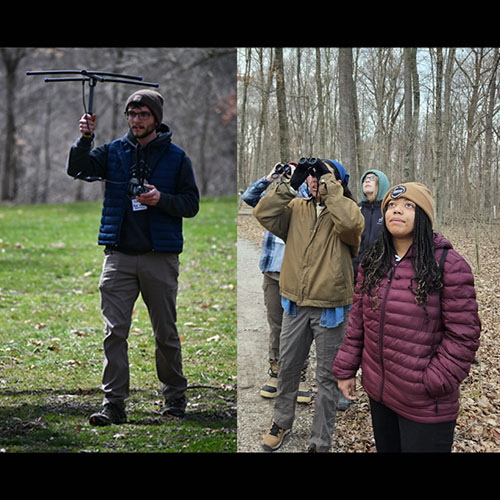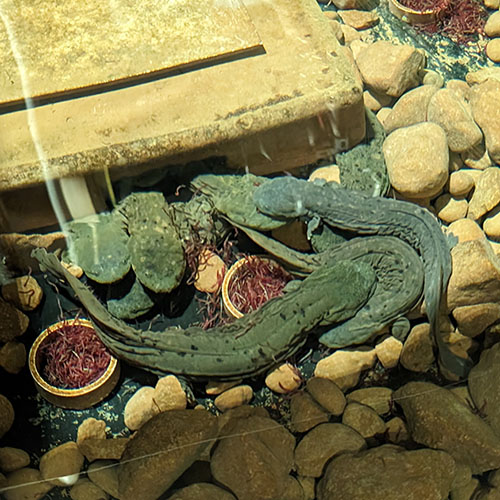Videos on the Purdue Forestry and Natural Resources Extension YouTube channel received more than 213,000 views in 2023. The Top 50 videos included 47 editions of ID That Tree, an informational series by Purdue Extension forester Lenny Farlee, as well as a webinar by Farlee on How to Identify Trees in Indiana. The remaining two videos in the Top 50 were an instructional video about a common urban tree planting problem by former Purdue Extension urban forester Lindsey Purcell, and a video about the use of prescribed fire on the Hardwood Ecosystem Experiment.
Below we will count down the 10 most viewed Purdue FNR Extension videos of 2023 with a few bonus videos sure to shoot up the list in future years.
Our most viewed video in 2023 was ID That Tree: Black Walnut with a whopping 18,156 views. This video has been seen more than 28,000 times since its debut in September of 2020.
1 - ID That Tree: Black Walnut -- Learn the identifying characteristics of the black walnut tree, also known as the American black walnut or eastern black walnut, including pairs of leaflets running down each stem, long running ridges on the bark, and round nuts that have a very strong exterior. This sun-loving tree also needs high quality soil.
Our second most viewed video is ID That Tree: American Elm. This video, which debuted in June 2020, was watched 16,779 times in 2023, and has been viewed 33,456 times overall.
2 - ID That Tree: American Elm -- In this tree identification series you will see how American elm leaves have jagged edges with a large tooth and then smaller teeth like edges on top of it. Find out why these trees are not as easy to find as they used to be.
Number three on our most viewed list is ID That Tree: Black Oak. This video, which debuted in March 2021, was seen 5,773 times in 2023.
3 - ID That Tree: Black Oak -- In this episode of ID That Tree, we continue to get to know the oak groups, this time focusing on the black oak species. Deep sinuses on the leaves and shinier coat, a dark blocky bark and acorns with loose shingle-like plates on the cap are some key identifiers to separate it from the red oak and others.
Number four on the most viewed videos list was ID That Tree: Invasive White Mulberry. This video, which debuted in September 2021, was seen 5,197 times in 2023.
4 - ID That Tree: Invasive White Mulberry -- On this episode of ID That Tree, Purdue Extension forester Lenny Farlee introduces you to a non-native invasive tree that is widespread across the state, white mulberry. Key identifying characteristics to separate it from its native cousin red mulberry are shiny variable leaves and where the species grows, near fence rows, hedgerows and other waste areas. The red mulberry has larger leaves that are duller in color with a sandpapery texture, and the species is often found in the forest understory.
Fifth on our countdown of top videos of 2023 is ID That Tree: Pignut Hickory. This video, which debuted in March 2022, was seen 4,569 times in 2023.
5 - ID That Tree: Pignut Hickory -- In this edition of ID That Tree, meet another member of the hickory family that can found in upland areas, the pignut hickory. This species is identifiable by its five-leaflet compound leaves, its smooth round nut and partially open husk.
Number six on our list of top videos for the year is ID That Tree: Northern Catalpa. This video, which debuted in August 2021, was watched 4,489 times in 2023.
6 - ID That Tree: Northern Catalpa - On this episode of ID That Tree, meet the Northern Catalpa, native to southern Indiana along the Ohio River bottoms. This species, which provides rot resistant wood great for outdoor usage, features beautiful flower clusters in early summer, huge heart shaped leaves in whirled formation, and long bean-like fruit pods.
Number seven on our Purdue FNR Extension most viewed list is ID That Tree: Sassafras. This video, which debuted in July 2020, was seen 4,481 times in 2023. Graduate student Olivia Bingham is
researching sassafras wilt in Indiana and needs your help with possible sightings across the state.
7 - ID That Tree: Sassafras -- Join Purdue Extension forester Lenny Farlee as he introduces you to the Sassafras in this edition of ID That Tree. The Sassafras is well known for the tea made from its bark and also for having a variety of shaped leaves from zero to three lobes.
Eighth on our 2023 most watched videos list is ID That Tree: Red Pine. This video, which debuted in February 2022, was seen 4,470 times in 2023.
8 - ID That Tree: Red Pine -- This week on ID That Tree, Purdue Extension forester Lenny Farlee introduces you to a non-native conifer that can be found throughout the state, the Red Pine. This species, which enjoys sandy soil, is identifiable by its small, egg-shaped cones, as well as tufts of needle pairs, which can be quite brittle, and orange/reddish bark.
Number nine on our most watched list is ID That Tree: Pin Oak. This video, which debuted in December 2021, was viewed 4,100 times in 2023.
9 - ID That Tree: Pin Oak -- On this edition of ID That Tree, meet a species of native Indiana oak from the broad red/black oak family, which is found in bottomlands and areas with imperfectly drained soil, the Pin Oak. This species is recognizable by round acorns with flat scales, bristle-tipped leaves with deep 90-degree angled lobes, and lower branches that angle downward.
Number 10 on our most watched list is ID That Tree: Honey Locust. This video, which debuted in October 2021, was seen 3,510 times in 2023.
10 - ID That Tree: Honey Locust -- This native tree comes with its own defense system in very large thorns on the stems and trunk. Meet the honey locust. Purdue Extension forester Lenny Farlee explains that large, long yellow seed pods that resemble bean pods, the option of single or doubly compound leaves on the same tree and smooth gray bark also help identify this species.
FNR Extension debuted 20 videos in 2023, 19 from the ID That Tree series and one from the Woodland Management Moment series, both produced by Lenny Farlee. The top three video debuts from the past year are listed below. Check them out and make sure to see all that Purdue FNR Extension has to offer on YouTube through the
playlists from ID That Tree to the Woodland Management Moment to A Moment in the Wild and more.
Our most viewed 2023 debut was ID That Tree: Chokecherry. This video made its appearance on July 28, 2023 and racked up 2,652 views the rest of the year.
1 - ID That Tree: Chokecherry -- In this episode of ID That Tree, Purdue Extension forester Lenny Farlee introduces the Chokecherry. This species is found in the North Woods of Northern Wisconsin and the Upper Peninsula of Michigan as well as natively in Indiana in small/medium shrub form. This species has alternately held broad leaves with finely toothed margins, and has short leaf stalks. The stems are a light to medium gray color and have prominent lenticels scattered along them.
Our second most watched 2023 video was ID That Tree: Balsam Fir. This video debuted on June 16, 2023 and was watched 2,403 times.
2 - ID That Tree: Balsam Fir -- In this episode of ID That Tree, Purdue Extension forester Lenny Farlee introduces the Balsam Fir. This species is found in the North Woods of Northern Wisconsin and the Upper Peninsula of Michigan. It's the primary fir found in the area and features soft and aromatic needles, which are flattened and have white stripes along the underside. Another notable characteristic is the three buds at the end of the twigs. This species can be easily identified from a distance due to its tight pointed spire like appearance.
Number three on our list of 2023 debut videos was ID That Tree: Scotch Pine. This video, which debuted on March 29, 2023, was seen 1,940 times in 2023.
3 - ID That Tree: Scotch Pine -- In this edition of ID That Tree, meet the scotch pine, or Pinus sylvestris, which is not native to Indiana, but has been planted in the state for Christmas tree production. This conifer, also known as Scots pine, has clusters of two blue green or yellow green needles, which are one to three inches long and do not break when bent. Bark on the scotch pine is light gray on the outside and orange in color on the inner bark, but it is not flaky like red pine. On the tree, cones are cylindrical and pointed at the ends, are approximately three inches long and do not have spines on the end of the scales. Cones become more egg shaped as the scales begin to open up once off the tree.





